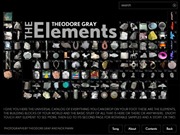 Publishing Perspectives has an interesting profile of Touch Press, the company behind “The Elements”, the periodic table app for the iPad that we’ve mentioned a time or two.
Publishing Perspectives has an interesting profile of Touch Press, the company behind “The Elements”, the periodic table app for the iPad that we’ve mentioned a time or two.
The company was founded by scientist and author Theodore Gray, who came up with a pictorial periodic table poster now found in many schools. Gray and Touch Press’s CEO, Thomas Whitby, both collect elements, and met through bidding on the same pieces of plutonium on eBay. The Elements, an illustrated, interactive e-book application for the iPad, was one of the first apps that demonstrated the iPad’s full educational and multimedia potential, and was remarked on in a number of early reviews.
The Elements was published as a printed book first, by Black Dog and Leventhal who were skeptical about the iPad version being released. “But what has happened is that initially there were 100,000 copies of the book in print and now, after the iPad app, there are 300,000. Sales of the printed book have greatly increased as a result of the electronic version coming out. I think people buy the electronic book, love what it does, but also want to be able to give the book to people who don’t necessarily have an iPad.”
Whitby sees a synergistic future ahead for both interactive e-books and printed paper books—each does things the other cannot, such as being able to wrap and put a printed book under a trees. He would like to get all of Touch Press’s electronic books available on all platforms, but notes that “at the moment, the iPad is the best game in town.”
Touch Press is planning future projects on the solar system, jewels and gemstones, dinosaurs (apparently), and a “’landmark’ TS Eliot poem”.
It’s interesting that the most interactive books are non-fictional in nature. Though I suppose it makes sense. When we read a fiction story, the only “interaction” we want is our imagination interacting with the words on the page. But when you’re trying to educate about something, you want to include material to support visual, auditory, reading/writing, and kinesthetic (tactile) learning processes.
It used to be that you had to incorporate those styles in a class, not a text, but interactive books might make it possible to combine all four into an app instead.































I beg to differ re interactive fiction. The games Myst and Riven are good examples. Fiction writers can and eventually will rise to this challenge